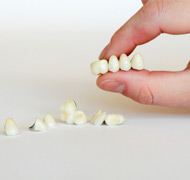
Teeth Whitening
It's an unavoidable fact: your teeth will darken over time. Food, drinks, tobacco, improper oral hygiene, even injuries and illness can all cause your smile to tarnish. But a white, bright smile makes a great impression, which is why we offer effective tooth whitening services.
If you've used over-the-counter solutions for teeth whitening, chances are you've been disappointed. For truly great tooth whitening, you need:
- Trained profesionals
- Industry-prove methods
- Advanced technoogy
- Acess to the latest and greatest dentistry has to offer
That's exactly why our tooth whitening is the best! Come in for a consultation, and let our experienced team recommend a whitening solution catered to your needs. From light-activated gels to take-home trays, we have access to prescription-level whitening systems that you simply can't find anywhere else.
Veneers
Veneers are thin, semi-translucent "shells" typically attached to your front teeth. Veneers are customized from porcelain material and permanently bonded to your teeth. Veneers are a great alternative to otherwise painful dental procedures to improve the appearance of your smile.
Common problems that veneers are used for:
- Spaces between the teeth
- Broken or chipped teeth
- Unsightly, stained or discolored teeth
- Permanently stained or discolored teeth
- Crooked or misshapen teeth
Veneers are a great aesthetic solution to your smile that may even help you avoid orthodontic treatment. Subtle changes to your smile can be achieved with veneers, and in most cases, veneer application is completed in only two office visits.
Please contact our office if you have any further questions on veneers.

Crowns and Bridges
Crowns
A crown is a permanent covering that fits over an original tooth that is either decayed, damaged or cracked. Crowns are made of a variety of different materials such as porcelain, gold, acrylic resin or a mix of these materials. Porcelain has the most natural appearance, although it is often less durable.
The treatment plan for a patient receiving a crown involves:
- Numbing the tooth to remove the decay in or around it.
- Re-sculpturing the tooth to provide an ideal fit for the crown.
- Making an impression of your teeth to create a custom-made crown (usually takes one to two weeks).
- Making a temporary crown out of acrylic resin and fitting it onto the tooth during the interim period when the permanent custom-made crown is being created.
- Applying the permanent crown (when received from the lab) by removing the temporary crown and fitting the permanent one onto the tooth.
- After ensuring that the crown has the proper look and fit, the dentist cements it into place.
This process generally consists of a minimum of 2-3 visits over a three to four week period. Once the procedure is completed, proper dental hygiene, including daily brushing and flossing, is required to maintain healthy, bacteria-free teeth, gums and crowns. This helps in the prevention of gum disease. Given proper care, your crowns can last a lifetime.
Bridges
A bridge is a dental device that fills a space that a tooth previously occupied. A bridge may be necessary to prevent:
- Shifting of the teeth that can lead to bite problems (occlusion) and/or jaw problems and resultant periodontal disease.
- Bridges safeguard the integrity of existing teeth and help maintain a healthy, vibrant smile.
There are three main types of bridges, namely:
- Fixed bridge- this is the most popular and consists of a filler tooth that is attached to two crowns, which fit over the existing teeth and hold the bridge in place.
- The "Maryland" bridge is commonly used to replace missing front teeth and consists of a filler that is attached to metal bands that are bonded to the abutment teeth. The metal bands consist of a white-colored composite resin that matches existing tooth color.
- The Cantilever bridge is often used when there are teeth on only one side of the span. A typical three-unit cantilever bridge consists of two crowned teeth positioned next to each other on the same side of the missing tooth space. The filler tooth is then connected to the two crowned teeth, which extend into the missing tooth space or end.
Implants
Dental implants are artificial tooth replacements that were first developed half a century ago by a Swedish scientist named Per-Ingvar Branemark. Implants arose from the patient's need to secure loose-fitting dentures. Since the advent of the implant, engineering and enhancements to the implant have enabled dentists to expand the implant's usefulness, including the replacement of missing or lost teeth. Today, implant techniques provide a wide range of tooth replacement solutions including:
- Single Tooth Replacement
- Anterior Replacement
- Posterior Replacement
- Full Upper Replacement
If the missing tooth space has no surrounding teeth, the dentist may decide an implant is the most appropriate treatment choice or option.
Post-Implant Care
Although proper oral hygiene is always recommended for maintaining good dental health, it is especially important when a patient has received a dental implant. Bacteria can attack sensitive areas in the mouth when teeth and gums are not properly cleaned, thus causing gums to swell and jaw bones to gradually recede. The recession of the jawbone will weaken implants and eventually make it necessary for the implant to be removed. Patients are advised to visit their dentists at least twice a year to ensure the health of their teeth and implants. Dental implants can last for decades when given proper care.
Composite Bonding
Bonding is a common solution for:
- Fixing or repairing chipped or cracked teeth
- Reducing unsightly gaps or spaces between teeth
- Hiding discoloration or faded areas on the tooth's surface
Often used to improve the appearance of your teeth and enhance your smile. As the name indicates, composite material, either a plastic or resin, is bonded to an existing tooth. Unlike veneers or crowns, composite bonding removes little, if any, of the original tooth.
Composite bonding has many advantages:
- It is a quick process, which typically lasts less than one hour.
- It does not reduce the tooth's original structure and is relatively inexpensive.
- Composite resins come in many different shades and provide better matching of shades to the natural color of your teeth.
- Composite bonds, however, are not as durable and long-lasting as veneers and crowns and may need to be re-touched or replaced in the future.
Composite bonds stain more easily and therefore require proper care and regular cleaning. In order to ensure the longest possible duration of the bonding, composites should be brushed and flossed daily. Common staining elements include coffee, tea, tobacco, foods, and candy.
See our real life smile transformations and related topics in our video library!

